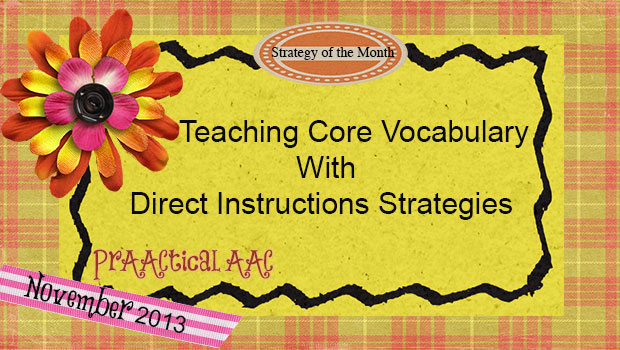Teaching Core Vocabulary with Direct Instruction Strategies

Vocabulary instruction involves a systematic TEACHING process. Core vocabulary words are harder to represent with pictures but still need to be taught with direct instruction. Many of the strategies and activities are part of general vocabulary teaching. Decide your core word vocabulary to teach and begin with strategies, steps, and fun activities.
Teaching Strategies
Teach in Meaningful Language Experiences– Create activities about the words but also about the communication behind the words. Develop activities that are meaningful to the learners.
Provide Active Participation Opportunities- Develop many, many (many) opportunities for the learners to use the vocabulary as an expressive communication tool as well as for receptive language. Have the learner interact with the core word vocabulary rather than just listen to explanations. Give the vocabulary communicative power for the learner.
Use Aided Language Input– Model AAC style.
Use Focused Language Stimulation – Highlight new words and use them repetitively. We like to think of it as if anyone was watching, they would definitely know the target words even if they did not have a ‘lesson plan’.
Teach Using Repetition with Variety- Use many activities that target the same core vocabulary in similar ways but that are different by details. Find ‘pretty’ flowers, then search for ”pretty’ rainbows.
Provide Specific Reinforcement- When teaching vocabulary, we want to use specific vocabulary reinforcement, without forgetting about natural communication reinforcement for using the target words.
Use Scaffolding– Use previous knowledge of words to relate to the new core vocabulary.
Use All Modalities of Language– Create activities using talking, listening, reading, and writing.
Presume Competence- Do not assume anything but that ALL learners can benefit from direct vocabulary instruction.
STEP 1: Introduce the new word(s)
STEP 2: Teach the new word(s) with explicit instruction activities
STEP 3: Elaborate on the new word meanings with engaging practice activities
STEP 4: Provide repeated exposure to the new word(s) on an ongoing basis
STEP 5: Check for understanding and re-teach, as necessary.
Activity Ideas
Words of the Week- Write words or gather remnants of in boxes, on a wall, in books. Read books that include words of the week. Highlight or sticky note the ‘target words’. Use a Word Wall and have learners add pictures, objects, remnants, text, etc. that define, categorize, or semantically relate to the target words. As the word wall becomes an important part of vocabulary instruction and learners are familiar with it, add some visual markers for where different items would be placed (i.e., parts of speech, fun words, impactful words, etc.). Create Word of the Week books. These can be tangible books, folders with pockets, talking power point books, talking photo albums, etc. Keep in mind to use the principles of active participation (i.e., Let learners glue, stick, record speech, type to help create the books). You can also create Word of the Week boxes. Again, keep principles of active participation in mind. Students can put items in a box, decorate the box, close the box, move the box, etc. Remember this is not a test, it is teaching so initially all items for the student to put in the box should be correct options.
Scavenger/Treasure Hunts- Go searching for items that relate to the core vocabulary or hide written words and go searching. To make it fun for learners, you can dress up as ‘treasure hunters, give clues, have teams, and/or have a treasure map. For older and more advanced language learners, the treasure hunt can be more sophisticated and involve asking peers for clues.
Word Art- Create word clouds, embed words in images that relate to experiences with the word, word banners, etc. Hang the creations up, alert visitors to the art, make a big deal about the projects.
Absurd Word Shouts, Whispers, Talk like a Pirate Like A Pirate- Help everyone ‘say’ the words in funny, scary, different ways. You would be surprised at how many learners like this and then will use it to tell jokes later.
Races to Find Words in Unexpected Opportunities- Have special alerts or wands that learners can use when they unexpectedly use or see the target words. Then give ‘points’ to see how many times the words were found during the week. If you are in a classroom, the class could go for a group target number. If you are with one learner, the target number can be for the facilitator and learner and when you ‘win’, there could be a word prize or certificate.
Word Parties- Have end of the week and end of the month word parties. Use party materials and food that motivate the learners. Make vocabulary learning fun.
More Vocabulary Resources
AAC Vocabulary Instruction Round-Up
A Year of Core Word Vocabulary
Filed under: Strategy of the Month
This post was written by Robin Parker

